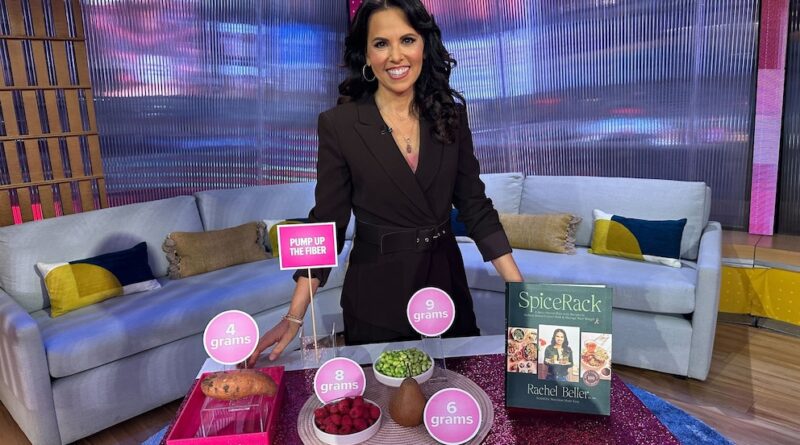5 tips and expert tips for eating foods high in fiber and antioxidants
For home cooks looking to add a healthy boost to breakfast or satisfy their sweet tooth when dessert is too much to eat, Rachel Beller has easy swaps for any plate. can have a strong impact.
Pink Power: Dietary Tips for Overeating
Beller joined “Good Morning America” on Tuesday with three simple, but unexpected ways to add breakfast, lunch or dessert that can help reduce other risks. of cancer.

Rachel Beller is a nutritionist with a multitasking diet and her cookbook, “SpiceRack: A Spicy Action Plan with Recipes to Reduce Your Risk of Breast Cancer and Manage Your Weight.”
ABC News
And while there is no single diet or food that can prevent or cure cancer, the author of the “SpiceRack” cookbook has created several recipes aimed at helping reduce breast cancer risks and manage weight. about what people eat from time to time.
These nutritional supplements contain delicious, nutrient-dense foods that research shows can help at the cellular level to reduce those risks.
Eat breakfast first with fiber
Beller understands that consistently meeting fiber goals can be a challenge as research suggests that the optimal amount to reduce risk is 30 to 35 grams of fiber per day.
His suggestion? Load up your day with 10 to 15 grams before noon to help you reach your daily goal.
Fiber has been linked to a lower risk of cancer due to its ability to help with weight management, support hormonal balance, improve gut health and help balance blood sugar levels, according to research from the United States Department of Agriculture.
Fiber content of a typical breakfast
1 cup of raspberries or blackberries = 8 grams of fiber
1 pear = 6 grams of fiber
1 cup of edamame = 9 grams of fiber
1 avocado = 10 grams of fiber
One slice of wholemeal bread = 3 grams of fiber
1 cup of potatoes = 4 grams of fiber
Ways to reach morning fiber goals
Avocado chia spread on flourless bread: Total fiber ~ 11 grams
One slice yielded flourless bread, 3 grams
1/2 avocado, 5 grams
2 tablespoons of chia seeds, crushed in an avocado, 3 grams
Pear bliss parfait: Total fiber ~ 13.5 grams
Yogurt
Pear (diced), 6 grams
1 tablespoon protein powder, almonds, 1.5 grams
2 tablespoons of oat fiber, 6 grams
Nutritious dressing or sauce for a fiber-rich lunch
At lunch, Beller suggests packing nutrients to support overall health, such as her spicy dressing with flax seeds.
Garlic and onion in particular have been linked to a reduced risk of breast cancer, Beller shared from a 2019 case-control study.
Check out Beller’s recipes to add spice and flaxseed to lunch below.
Spiced Flax Dressing
Tools
2 tbsp ground flaxseeds
1 tsp Dijon mustard
2 tbsp rice vinegar or cider vinegar (or lemon juice)
2 tbsp olive oil
1 tsp Vegitude Power Spice Blend
Salt and pepper to taste
2-3 tbsp water (thin as needed)
Ways
Wash all the ingredients together in a small bowl or jar. Slowly add water, adjusting to your liking. Add salt and pepper to taste.
This dressing pairs well with roasted vegetables such as carrots, eggplants and other colorful vegetables. You can also use it as a salad dressing.
Parsley Strength Tonic
“Our drinks are another unexpected opportunity to continue adding more goodness to our day. I like to make this energy tonic as an after-meal drink to support digestion and GI comfort. . It’s full of powerful ingredients that can soothe digestion and provide additional antioxidants and anti-inflammatory properties,” said Beller.
“Parsley contains apigenin that can inhibit the growth of cancer cells and have anti-estrogenic properties,” according to a 2017 medical report on the plant flavone apigenin.
Tools
8 cups of water
2 fennel tea bags (or 2 teaspoons fennel seeds)
1 cup fresh parsley
1 teaspoon Ceylon cinnamon
Directions:
In a small saucepan, combine all the ingredients over medium heat.
Bring to a boil, reduce the heat to low, and allow 8-10 minutes until the spices are fragrant.
Strain (optional) and serve warm or cold. Store covered in the refrigerator for up to 4 days.
Add sesame seeds for a nutrient-dense dessert
Beller said these cookies made with sesame seeds and tahini, a paste made from ground seeds, “provide a satisfying meal, while packing a lot of nutritional benefits.”
“Sesame seeds are the second best food source of lignans, after flaxseeds,” he said of plant compounds with anti-inflammatory and antioxidant properties.
In addition, the addition of almond flour adds a nutrient-dense base to keep the cookies light, but full of protein, fiber and healthy fats.
Sesame Cookies
Tools
1 1/2 cups of almond flour
1/2 cup tahini paste
2 tablespoons pure maple syrup
1 teaspoon vanilla extract
1 teaspoon Ceylon cinnamon
1/4 cup green sesame seeds
Directions:
Preheat your oven to 350°F and line a baking sheet with parchment paper.
In a mixing bowl, combine the almond flour, tahini, maple syrup, vanilla extract and cinnamon. If the mixture is too dry, add a little plant milk until it forms a dough that can easily be rolled into balls.
Place the sesame seeds on a plate. Form the dough into 18 small balls, then sprinkle them with sesame seeds to coat.
Transfer the balls to the prepared baking sheet and cover with another piece of parchment paper. Use your hand to flatten each ball into a cake shape. Remove the top layer of skin.
Bake for 10-15 minutes, or until the sesame seeds are brown.
Allow the cookies to cool for 10 minutes before serving. Have fun!
#tips #expert #tips #eating #foods #high #fiber #antioxidants

